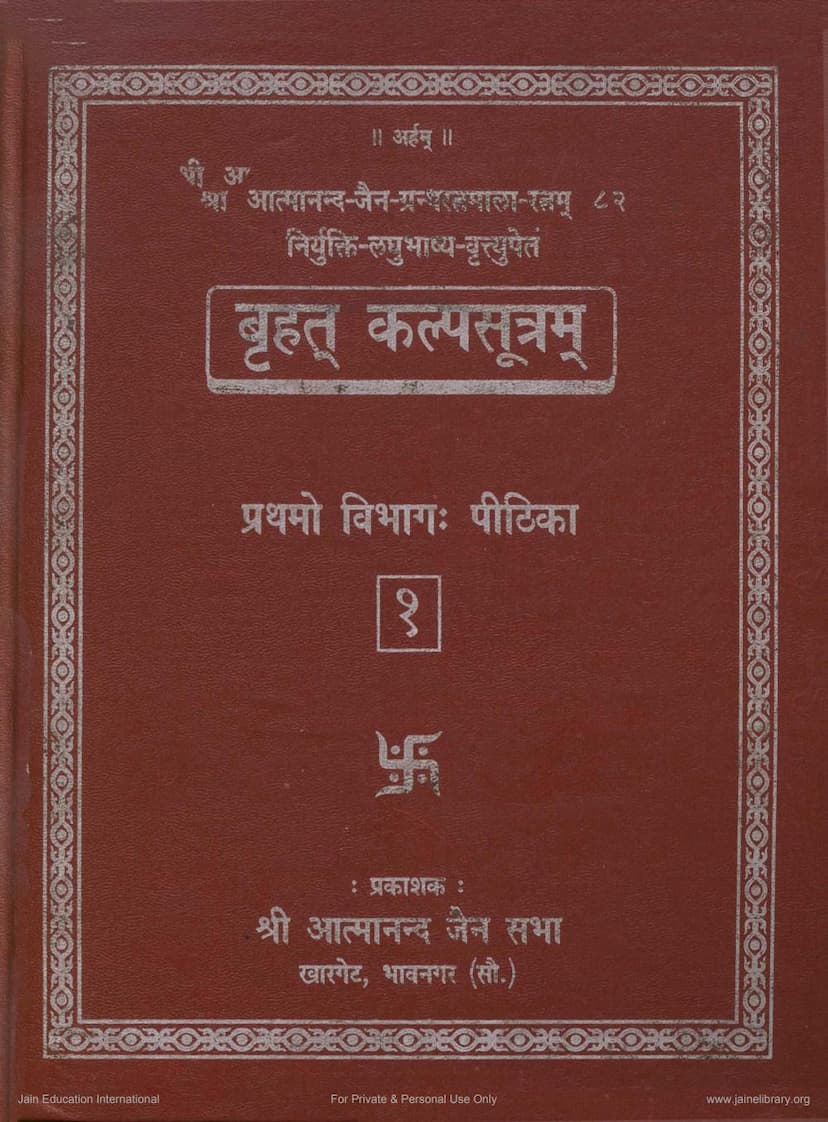Agam 35 Chhed 02 Bruhatkalpa Sutra Part 01
Added to library: September 1, 2025

Summary
Here's a comprehensive summary of the provided Jain text, Agam 35 Chhed 02 Bruhatkalpa Sutra Part 01, based on the pages you'T provided:
Overall Title: Brihat Kalpa Sutra (बृहत् कल्पसूत्रम्) Volume: Part 1 (First Division: Introduction/Pithika - प्रथमो विभागः पीठिका) Author/Compiler: Originally composed by Bhadrabahuswami (identified as the author of the original Nikshepa), with subsequent additions and elaborations by Acharya Sanghadasganikshamashraman (for the Laghu Bhashya), Acharya Malayagiri Suri (for the initial commentary on the Pithika), and completed by Acharya Kshemkirti (of the Vrahal-tapagachchha). Publisher: Shri Atmanand Jain Sabha, Khargate, Bhavnagar. Context: This is the introductory section (Pithika) of the Brihat Kalpa Sutra, a fundamental Jain Agam text dealing with monastic conduct and rules. The provided pages cover the title pages, publisher information, acknowledgments, dedications, and the initial commentary (Pithika Vrutti) on the introductory verses and concepts.
Key Aspects and Content Summarized:
-
Title and Authorship:
- The text is identified as Brihat Kalpa Sutra (बृहत् कल्पसूत्रम्).
- It is noted to be accompanied by the Nikshepa (निर्युक्ति) composed by Bhadrabahuswami (भद्रबाहुस्वामी).
- The Laghu Bhashya (लघुभाष्य), compiled by Sanghadasganikshamashraman (सङ्घदासगणिक्षमाश्रमण), is also mentioned as a key commentary.
- The Pithika (introduction) itself is a commentary, initiated by Acharya Malayagiri Suri (आचार्य श्री मलयगिरि सूरी) and completed by Acharya Kshemkiriti (आचार्य श्री क्षेमकीर्ति). This highlights the layered nature of the text, with original teachings, foundational commentaries, and later elaborations.
-
Publisher and Edition Information:
- Published by Shri Atmanand Jain Sabha, Bhavnagar. presents a list of books published by the Sabha.
- The preface mentions the effort in reprinting the volumes, noting that the earlier editions, particularly the first published 60 years prior, had become unavailable.
- It specifically acknowledges the contribution of Muni Chatura Vijay and Muni Punyavijay in the meticulous editing and compilation, referring to their work based on original manuscripts and printed copies, including corrections made by Muni Punyavijay based on further research.
- The text includes details about the manuscripts (Prati - प्रति) used for the revision, listing their sources (e.g., Patan Jain Bhandars, Ahmedabad Dhelai Upashray Bhandar, etc.) and providing codenames (भा, त, डे, मो, ले, कां). It also describes the physical characteristics of these manuscripts and notes their general condition and age.
-
Purpose of the Pithika (Introduction):
- The Pithika serves as an introduction to the main text, explaining its significance, the authors, and the context of its compilation.
- It emphasizes the importance of Mangala (मंगल - auspicious invocation) at the beginning, middle, and end of scriptures, citing verses from the Visheshavashyak Sutra regarding the purpose of mangala.
- The introduction explains the origin and purpose of the Kalpa Sutra and its Nikshepa and Bhashya, highlighting how the original texts became difficult to understand over time due to the decline in human intellect and lifespan (Kal-krama), necessitating further commentaries for easier comprehension and preservation of the teachings.
-
Introduction to Jain Agamic Concepts:
- The initial verses and their commentary delve into fundamental Jain philosophical concepts, starting with Mangala (मङ्गल) and Nandi (नन्दी).
- Mangala is discussed in terms of its four forms: Nama (नाम - name), Sthapana (स्थापना - symbolic representation), Dravya (द्रव्य - material), and Bhava (भाव - internal state). These concepts are applied to the term 'Mangala' and 'Nandi'.
- Nandi is explained as the Jnanapanchaka (ज्ञानपञ्चक - the five types of knowledge): Abhinibodhika, Shrut, Avadhi, Manahparyaya, and Keval Gyan.
- The text then elaborates on the classification of knowledge into Pratyaksha (प्रत्यक्ष - direct) and Paroksha (परोक्ष - indirect), and further breaks down these categories.
- The commentary begins to analyze the meaning of 'Indra' (इन्द्र) and its application to these categories through the four Niskhepas (Nama, Sthapana, Dravya, Bhava), illustrating potential contradictions and their resolutions.
- There's a detailed discussion on the literal meanings (Nirukta - निरुक्त) of key terms like 'Kalpa' and 'Vyavahar', explaining their multi-faceted meanings and how they apply in the context of the scripture.
-
Methodology of Research and Presentation:
- The editors describe their meticulous process of selecting and comparing various manuscripts (Prati - प्रत) for textual accuracy.
- They explain their system for indicating textual variations (Pathantara - पाठान्तर) and corrections within brackets.
- The text includes extensive references to other Jain Agam texts and commentaries that were consulted, serving as important sources for verification and understanding.
-
Dedication and Gratitude:
- The publication is dedicated to the spiritual lineage and blessings of their Guru, Shri 1008 Shri Vijayanand Surivar (Shri Atmaramji Maharaj), acknowledging his influence in elevating the Atmanand Jain Grantharatnamala series.
- The editors express gratitude to the institutions and individuals who provided access to the precious manuscripts.
In essence, the provided pages represent the foundational elements of the Brihat Kalpa Sutra's first volume. They lay the groundwork by introducing the scripture, its commentators, the purpose of the introductory section, and begin the detailed exposition of core Jain epistemological concepts like the types of knowledge (Jnana) and the Niskhepas, essential for understanding the vast disciplinary rules that follow in the main text.